The steep foothills of India’s Eastern Himalayas are covered in tea plantations, alpine forests and mountain towns which appear to be clinging to the sides of steep mountain slopes. The majority of people are Tibetan Buddhists, which gives the area a unique and peaceful atmosphere.
Darjeeling began as a British military post responsible for safeguarding India’s borders with Nepal and Bhutan. Set at just over 2000 m (6700 ft), the hilly location was perfect for growing tea. It didn’t take long for the British to start planting tea trees on the surrounding hills, and soon after, a hill town was established. Having heard stories of Darjeeling for many years, I had a romanticized notion of this colonial hill town. Unfortunately, our high expectations were not fulfilled and Darjeeling was a disappointment. Far from the quintessential English highland town we were expecting, Darjeeling was quite dumpy. The buildings are set up and down on steep ridges and could be cute, but most of the buildings are run-down with no attempt at maintaining or beautifying them. Adding to the disappointment, it rained every day. Darjeeling and its hilltop lookouts were shrouded in clouds for our entire stay. We had hoped to have a view of the third highest mountain in the world, Kanchenjunga, from Tiger Hill. Sadly, we couldn’t even see the next ridge which was only 200 m away.

Darjeeling homes on the steep hills 
Street in Darjeeling 
Darjeeling homes on the steep hills 
Darjeeling homes on the mountain ridge
There are a few old British colonial remnants in Darjeeling including a tall, stone clock tower and St. Andrew’s church, but far fewer than we expected. Downtown Darjeeling could have been a lovely area with Chowrasta pedestrian mall on top of the mountain. Unfortunately, the buildings are mostly in disrepair and workers were doing a poor job at repairing the sidewalk. We walked through the botanical garden at the base of the hill, but had to search pretty hard to find any flowers. There were small greenhouses with a few potted plants, but not many were blooming.
Darjeeling’s elevation is quite high so it can get quite cold in winter months. The roads in this area are very steep and can be slippery when the temperature gets below freezing. Instead of requiring people to purchase better tires, the steep roads are studded with small, sharp rocks!

Clock Tower, Darjeeling 
St. Andrews Church, Darjeeling 
Chowrasta Mall (Pedestrian Mall), Darjeeling 
Studded streets, Darjeeling
One thing we did that was a lot of fun was taking the toy train from Darjeeling (2042 m) to Ghum (2225 m) and back. The 7 km, 180 m elevation gain trip took almost an hour as the train slowly puttered along the track. The toy train is an old British left-over; a steam engine on a narrow two-foot-wide track. It was fun to watch the smoke billow out from the engine. The train ride begins in the middle of Darjeeling and proceeds up the main road. There are many twists and turns on the road as it follows the mountain’s edge. Since the train can’t make sharp turns, the track goes from one side of the road to the other at every bend, to be on the widest part of the curve. Traffic often has to stop to allow the slow train to lumber by, but when the train isn’t on the track, it is used by cars and pedestrians. From the train we should have had nice views of Darjeeling on the steep hills and the mountains above, but the low, thick cloud impaired our views.
The train stopped for a few minutes at Batasia Loop where there is a small garden and a war monument. To make it up the small hill, the track makes a spiral formation where it crosses over its own line, hence the ‘Loop’ in its name. Our last stop was the village of Ghum where we walked to a small Buddhist monastery. As had been our luck lately, the clouds were so thick we could hardly see the monastery from a few meters away.
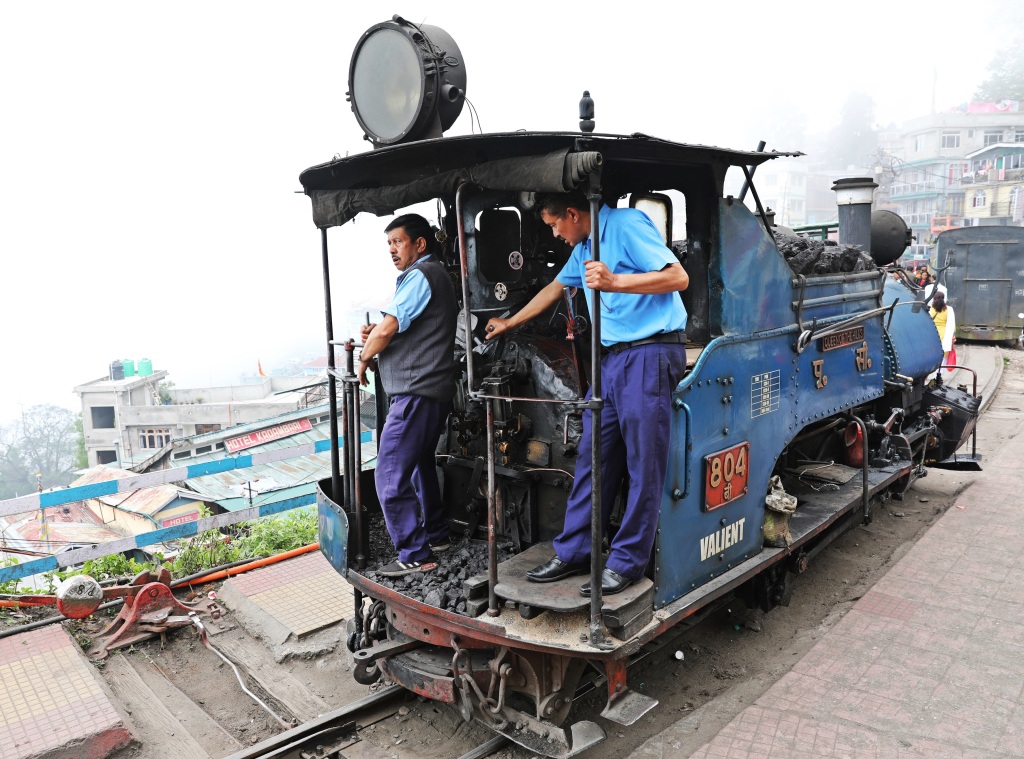
Engineers on Darjeeling’s Toy Train locomotive 
Toy Train Steam Engine 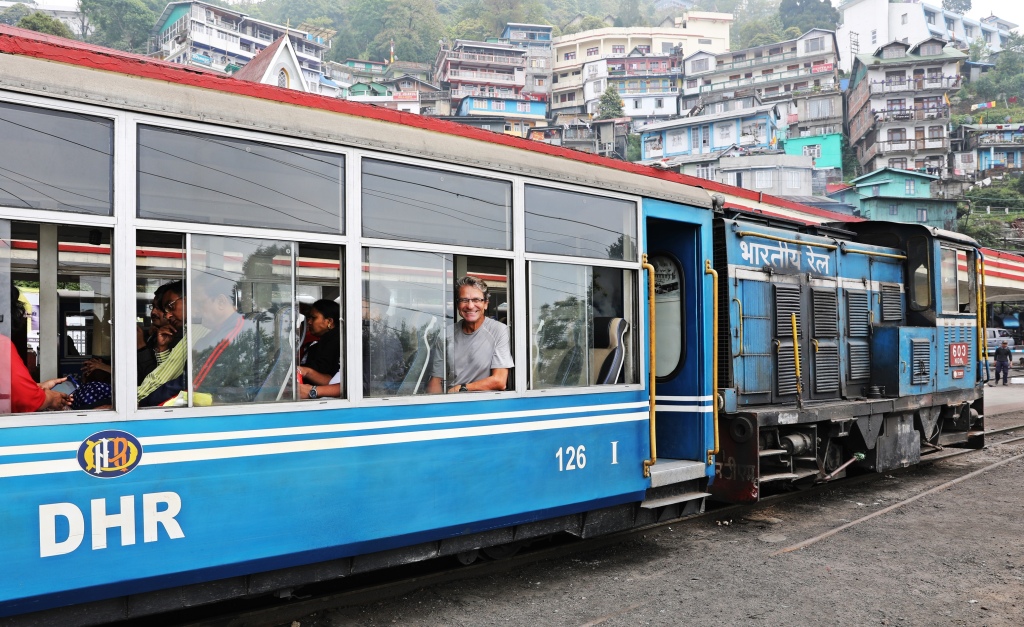
Darjeeling Toy Train 
Darjeeling Train Station 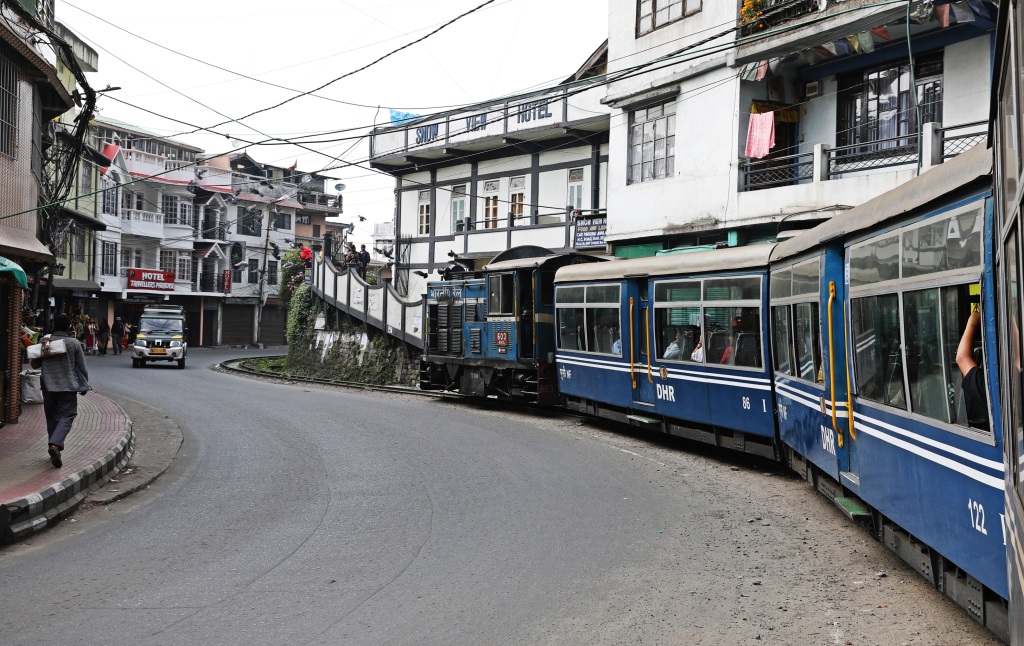
Toy Train on Darjeeling’s main street 
Toy Train at Batasia Loop 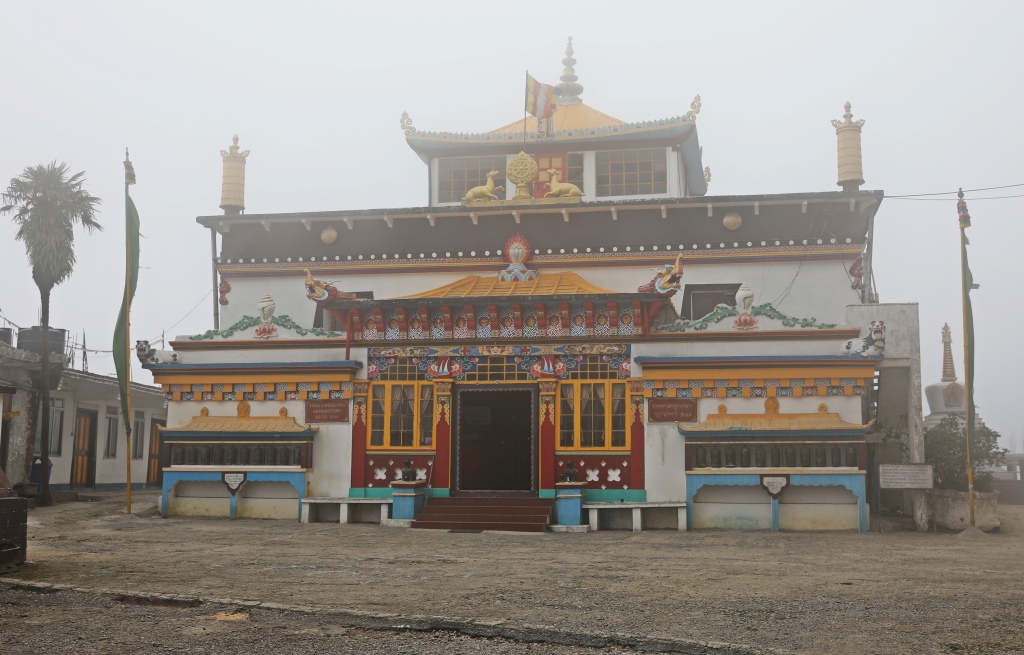
Gompa in clouds, Ghum
While in Darjeeling, we also visited the important Buddhist monastery, Dali Gompa. It’s a large complex on a hill east of Darjeeling. There are large, colourful frescos of Buddhist images on some of the outer walls. It’s a busy teaching monastery housing over 200 monks and students. A few of the student monks were curious about us and wanted us to take their picture, but others were very shy. There was a prayer-wheel room where we found both novice and elder monks sitting on stools spinning the prayer wheels by using a strap attached to the wheel. We haven’t seen a set up like that before.
On the other side of town, Bhutia Busti Gompa is a small monastery on the side of a hill. It has a traditional Kani (gate) at the entrance and a long walkway, bordered by prayer flags.

Darjeeling and Dali Gompa 
Darjeeling and Dali Gompa 
Frescoes, Dali Gompa, Darjeeling 
Prayer Flags, Dali Gompa, Darjeeling 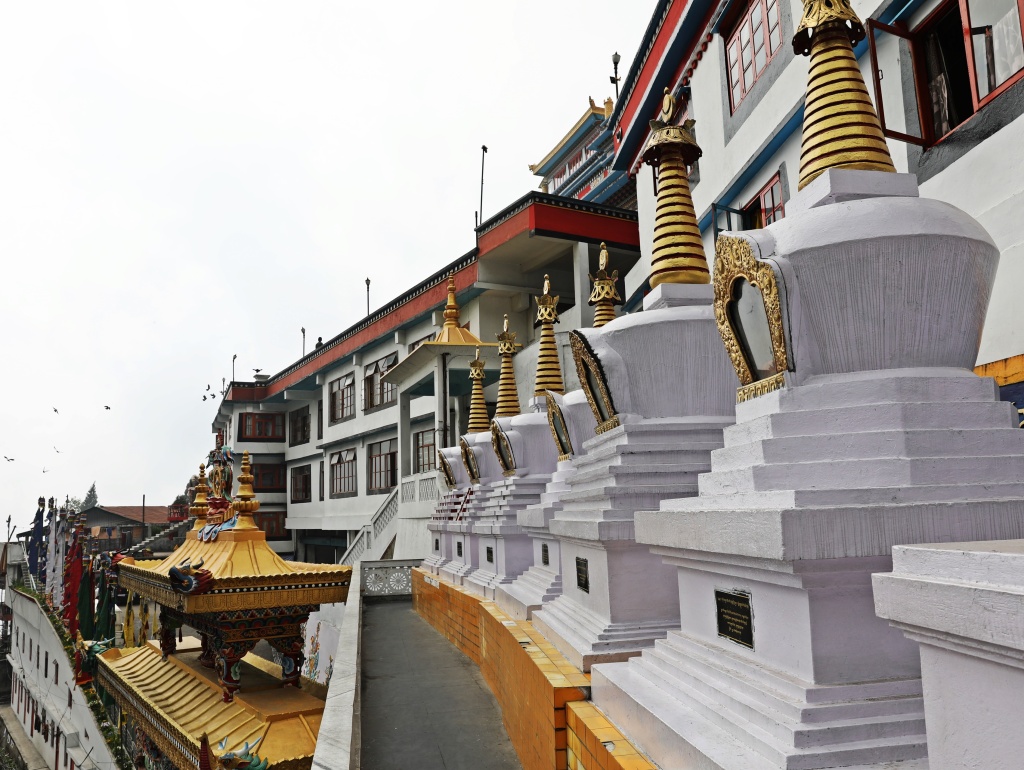
Chortens, Dali Gompa, Darjeeling 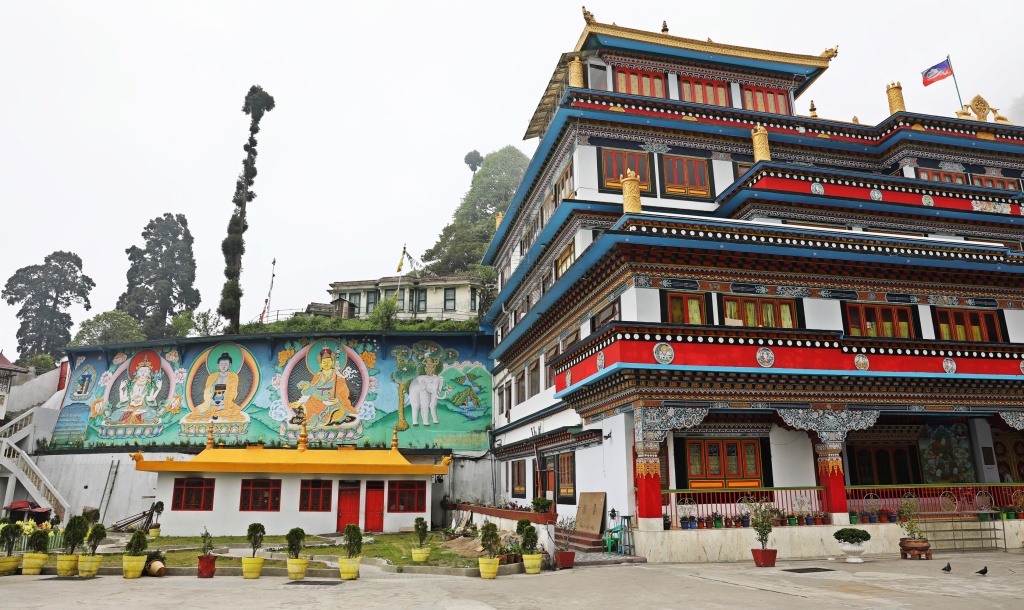
Frescoes and Audience Hall, Dali Gompa, Darjeeling 
Novice monk, Dali Gompa 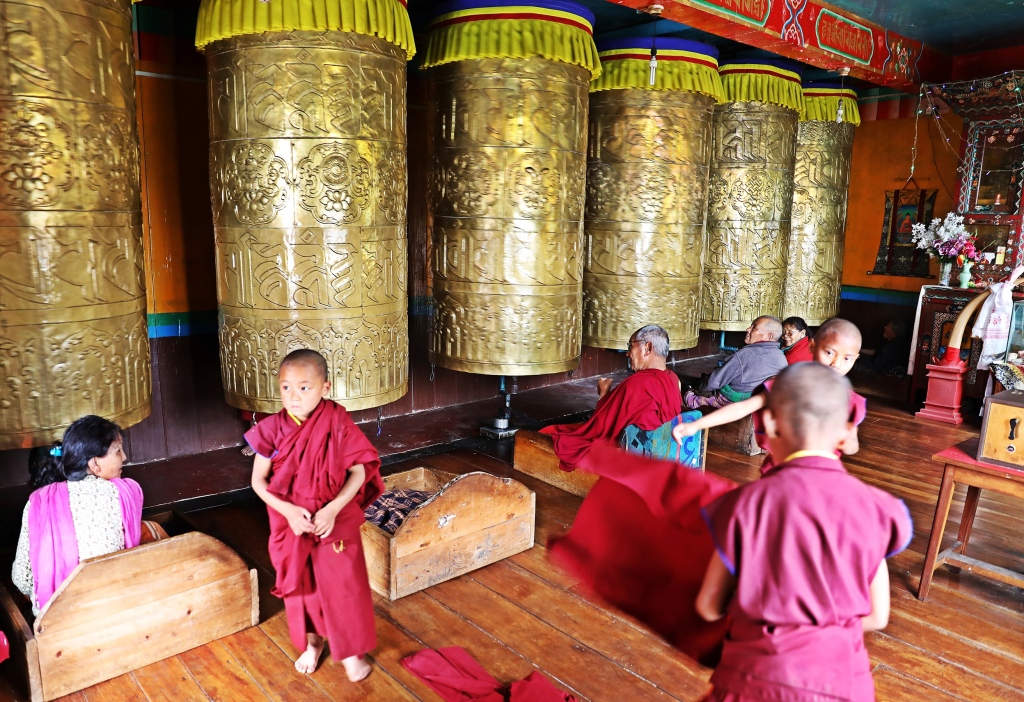
Hand operated prayer wheels, Dali Gompa, Darjeeling 
Roof top, Dali Gompa, Darjeeling 
Novice monks, One brave, One shy, Dali Gompa, Darjeeling 
Entrance to Bhutia Busti Gompa, Darjeeling 
Bhutia Busti Gompa, Darjeeling
Further up the hill in Darjeeling is the Japanese Peace Pagoda. It’s a tall thin structure with an interesting white staircase leading to a kora walkway. Around the base of the pagoda are golden Buddha statues. Across from it is a Japanese Buddhist Temple. Both the pagoda and the temple are very different from Tibetan architecture usually seen in the area. Walking down from the pagoda, we found a few lovely colonial homes that have been turned into hotels. This was the Darjeeling we were hoping for. Unfortunately, the lovely buildings were contained to one block.

Japanese Peace Pagoda, Darjeeling 
Golden Buddha, Japanese Peace Pagoda, Darjeeling 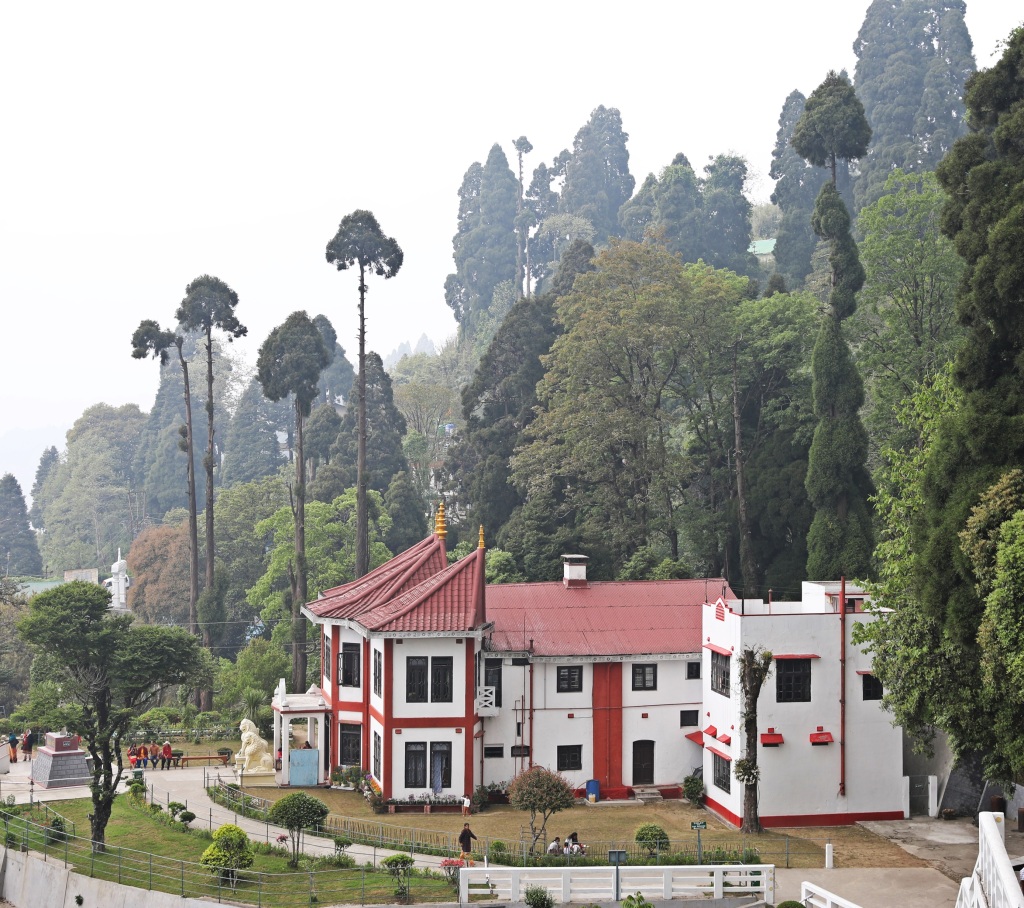
Japanese Buddhist Temple, Darjeeling 
Colonial buildings, Darjeeling
On our last day, the rain finally stopped, and the visibility had improved. We could finally see Tiger Hill Lookout across the valley, but we still couldn’t see the snow-capped Himalayas.
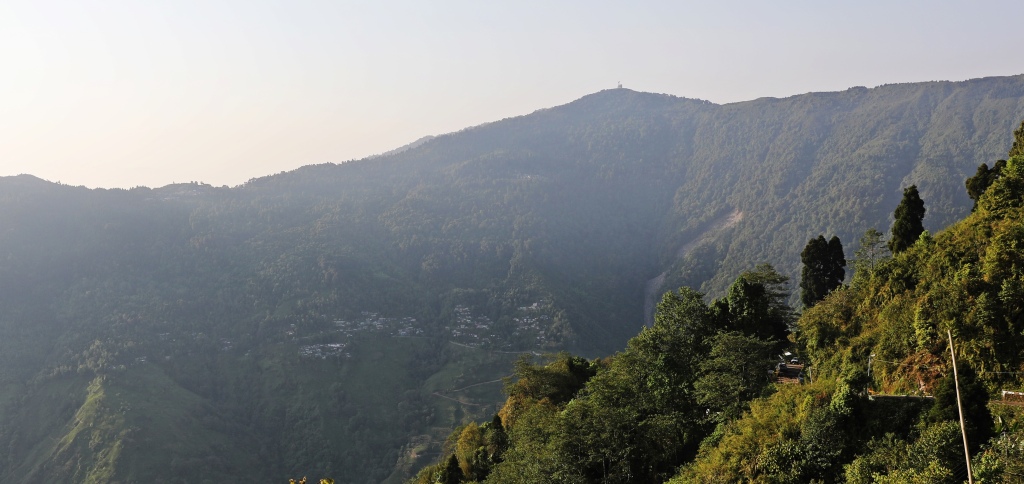
Tiger Hill, Darjeeling 
Clouds in the valley, Darjeeling
After Darjeeling we drove on mountain roads to the state of Sikkim. On the drive we were stopped for over an hour while road crews cleaned up a landslide. It was okay though because we were entertained by a troop of Assam Macaque monkeys. They are playful monkeys with short tails. After Darjeeling, we had low expectations for Gangtok, the capital of Sikkim. We were pleasantly surprised that this capital city has a clean pedestrian mall, lovely buildings with good restaurants and hotels. Local homes and businesses are mostly well taken care of and it was a pleasant city to explore. There’s a small park and a walking path on the mountain ridge above town. At the end of the ridge is Tsuglagkhang Royal Chapel and Gompa. It was once the temple for the royal Chogyal family. Behind the monastery is the understated former residence of the royals.

Assam Macaque monkey, Sikkim 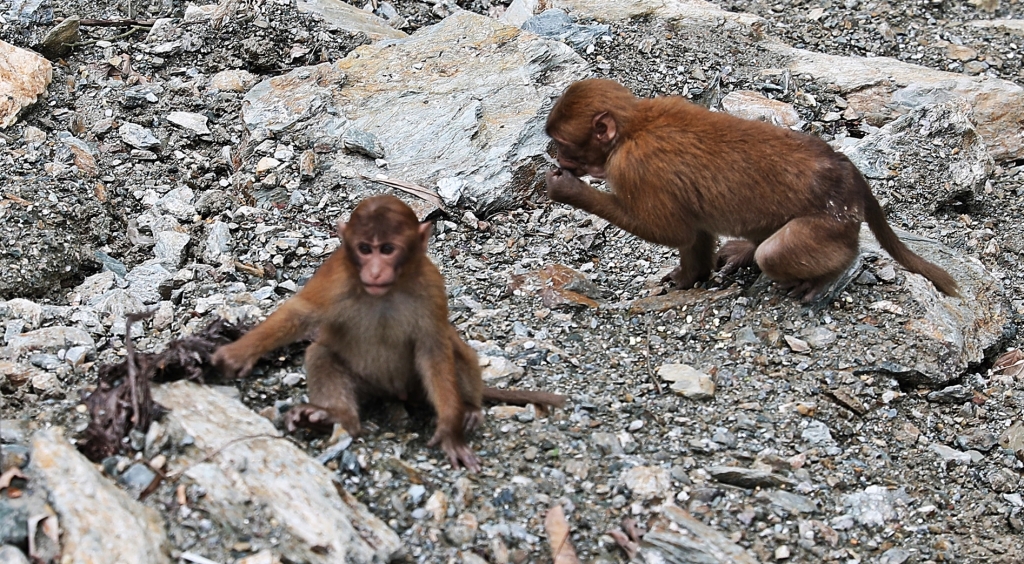
Assam Macaques, Sikkim 
Mountain view, Sikkim 
Mahatma Ghandi Marg (Pedestrian Mall), Gangtok 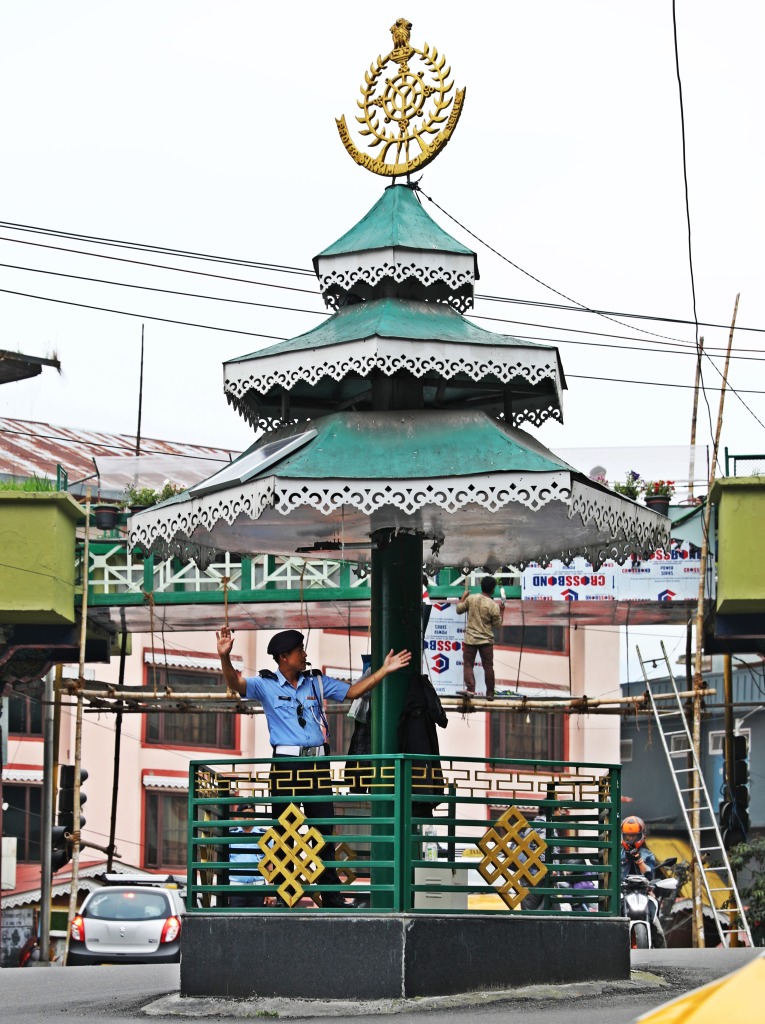
Traffic cop, Gangtok 
Tsuglagkhang Gompa, Gangtok 
Tibetan style window, Tsuglagkhang Gompa 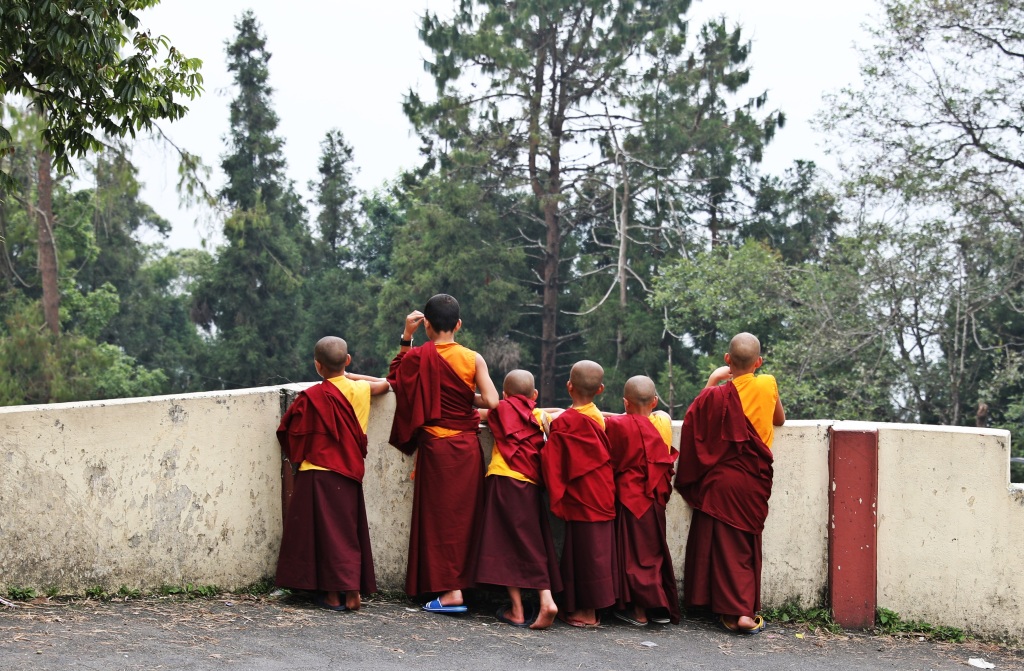
Novice monks, Tsuglagkhang Gompa 
Chogyal Palace, Gangtok 
New Hindu Temple, Gangtok
The most important site near Gangtok is Rumtek Gompa. It’s only 25 km away, but the drive takes 1hr 45min on winding mountain roads. It’s a very large complex which was built to replace Tsurphu Monastery in Tibet. This important monastery was destroyed in the Chinese cultural revolution in the 1960s. The monks here are from the Black Hat sect in reference to the colour of the hats they wear to special celebrations. The monastery complex is very large with many buildings for worship, education and residence. The main Audience Hall is surrounded by a large courtyard with many rooms around its perimeter. There were a lot of novice monks hanging around in the courtyard waiting for the puja (chanting ceremony) to begin. The entrance and inside of the Audience Hall is similar to other Tibetan Gompas with colourful paintings on the walls, tapestries hanging down from the ceiling and a large Buddha statue in the front. The puja was very lively with monks playing horns, oboes, dungchens and drums while chanting their mantras in unison. It was a great experience. Down the road we visited the Old Rumtek Gompa which was a smaller, more modest building. The monks were having a simple puja with fewer instruments. It has a very nice setting on a small plateau surrounded by mountains.
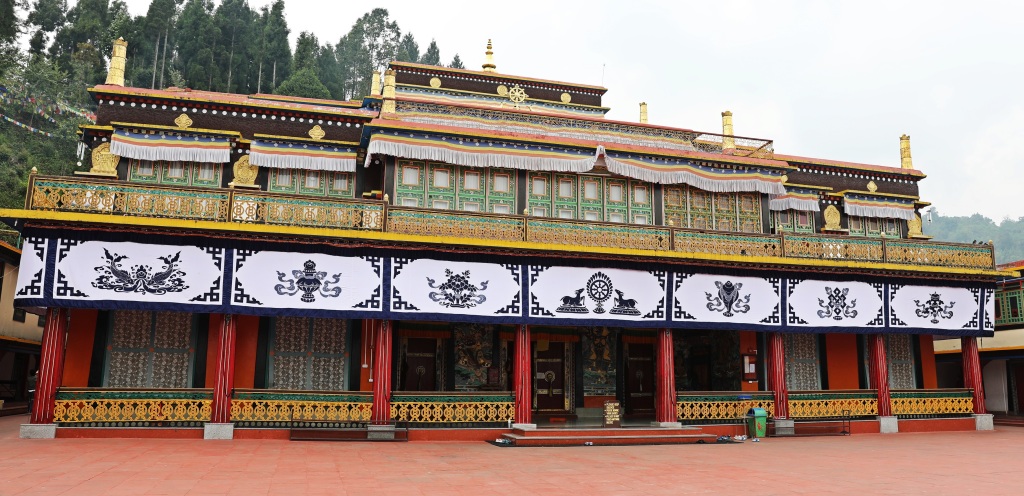
Audience Hall, Rumtek Gompa 
Rumtek Gompa 
Novice monks, Rumtek Gompa 
Courtyard, Rumtek Gompa 
Novice monk, Rumtek Gompa 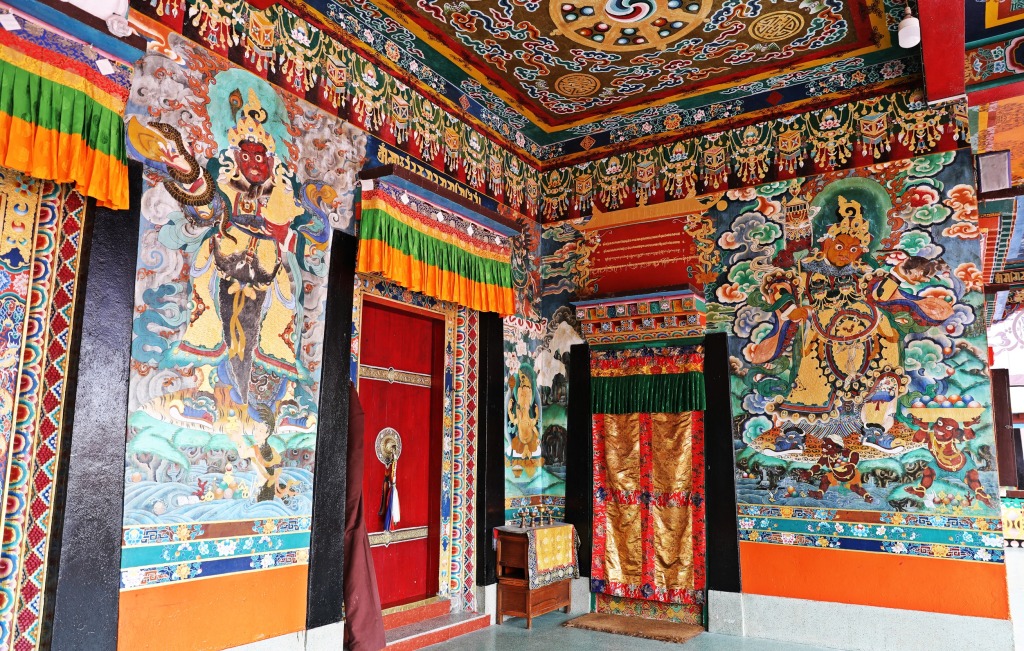
Colourful entrance, Rumtek Gompa 
Audience Hall, Rumtek Gompa 
Old Rumtek Gompa 
Puja in Old Rumtek Gompa
We came to this area to do a high-altitude trek to a viewpoint of Mt. Kanchenjunga. The trek begins in the small Buddhist village of Yuksom. As with any Himalayan town, Yuksom is home to families originally from Tibet. It’s a cute mountain village with homes scattered up and down the hills. The homes are humble, but well maintained and decorated with lovely flower gardens and potted plants.
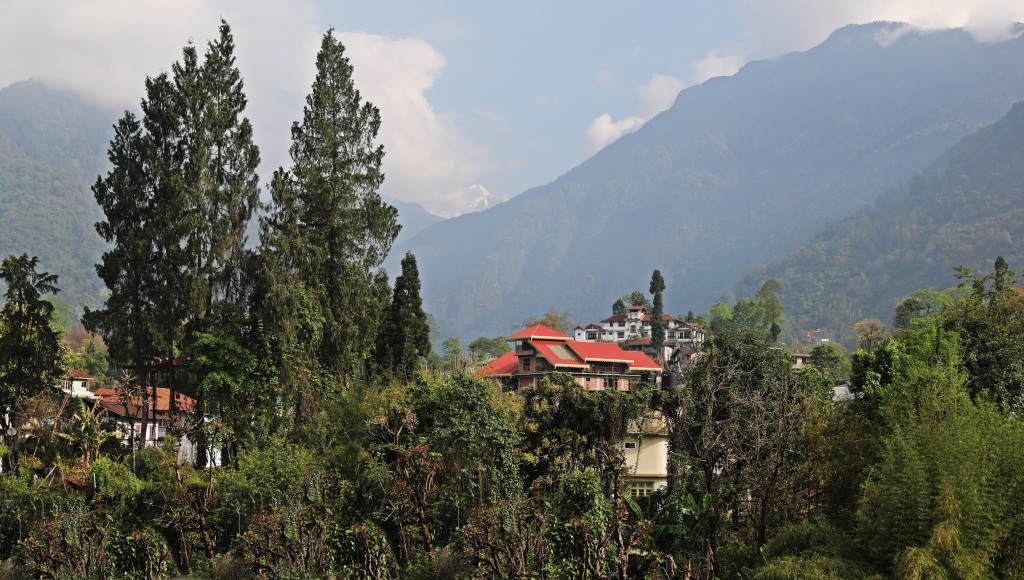
Yuksom with mountain views, Sikkim 
Yuksom street, Sikkim 
Home in Yuksom 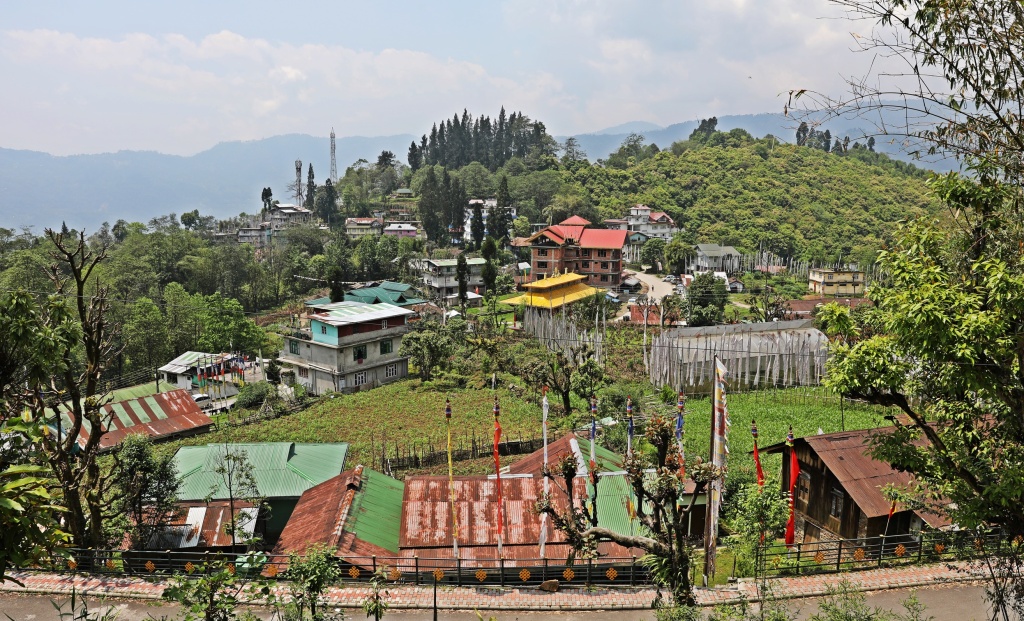
Homes in Yuksom
There are a few important Buddhist sites in Yuksom. We hiked to the top of a small hill above town to visit Dubdi Gompa. Established in 1701, it is the oldest monastery in Sikkim. On another hill is Norbugang Park and the Coronation Throne. In the 1600s, Tibetan monks chose the first leader of Sikkim, marking the beginning of the Sikkim Chogyal monarchy. The crowing of the first prince occurred on a stone platform under a large tree in this park. Today, it’s a peaceful, treed park with chortens and many prayer flags. Below the park is a large, new monastery with a huge statue of the important Buddhist sage, Rinpoche, who is the patron saint of Sikkim.
In town is the peaceful Kartok Lake surrounded by prayer flags and a new building with large prayer wheels. After a sunny day in Yuksom, we were ready for our 8-day trek to Goecha La.
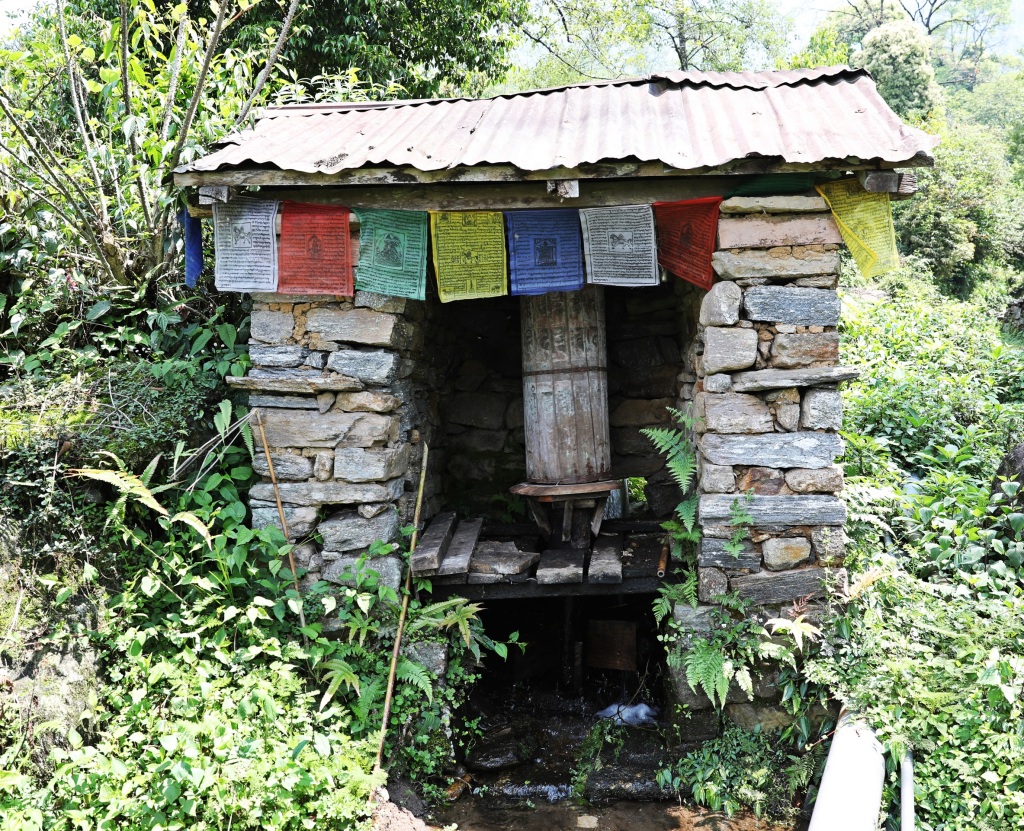
Water Prayer Wheel, Yuksom 
Chorten on they way to Dubdi Gompa, Yuksom 
Dubdi Gompa, Yuksom 
Chorton, Yuksom 
Buddhist Gompa, Yuksom 
Norbugang Park, Yuksom 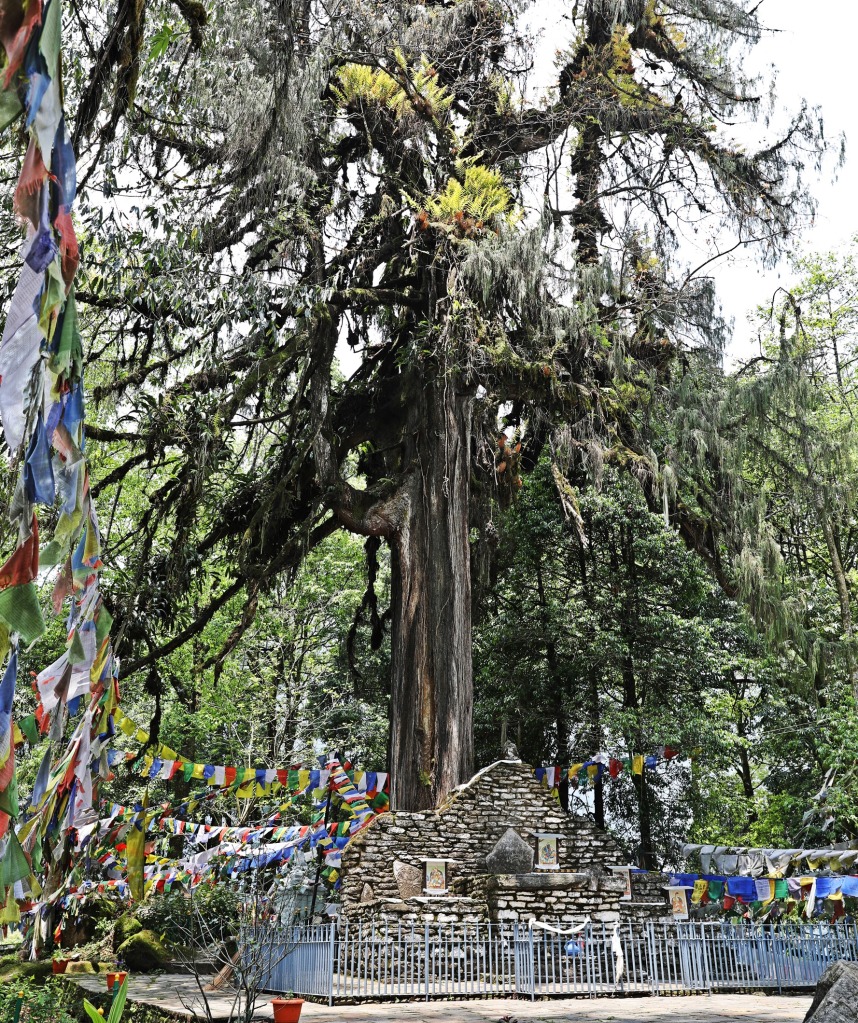
Coordination Throne, Norbugang Park, Yuksom 
Chorten, Norbugang Park, Yuksom 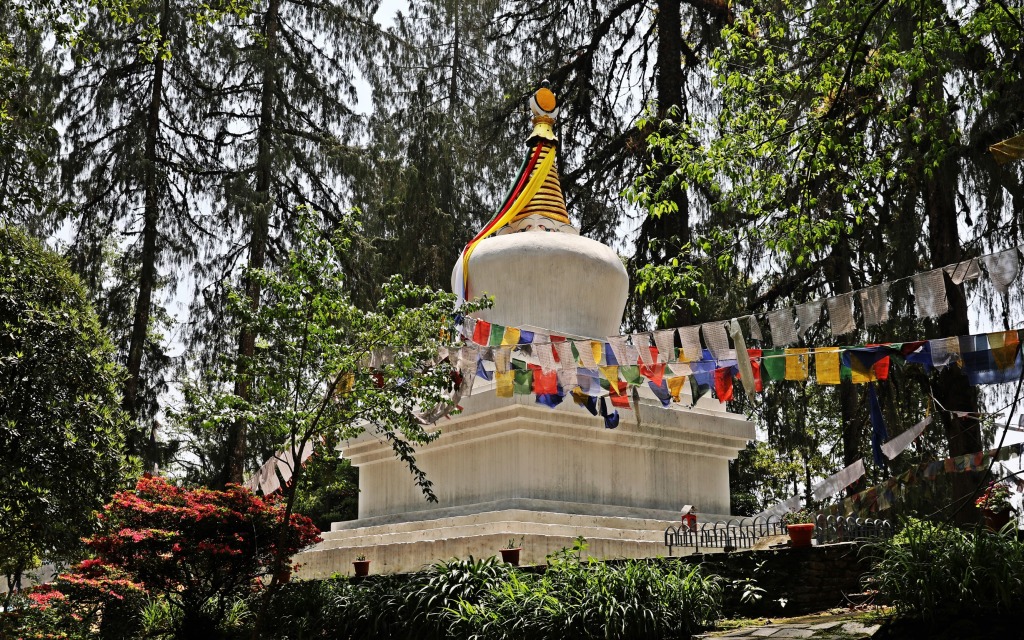
Chorten, Norbugang Park, Yuksom 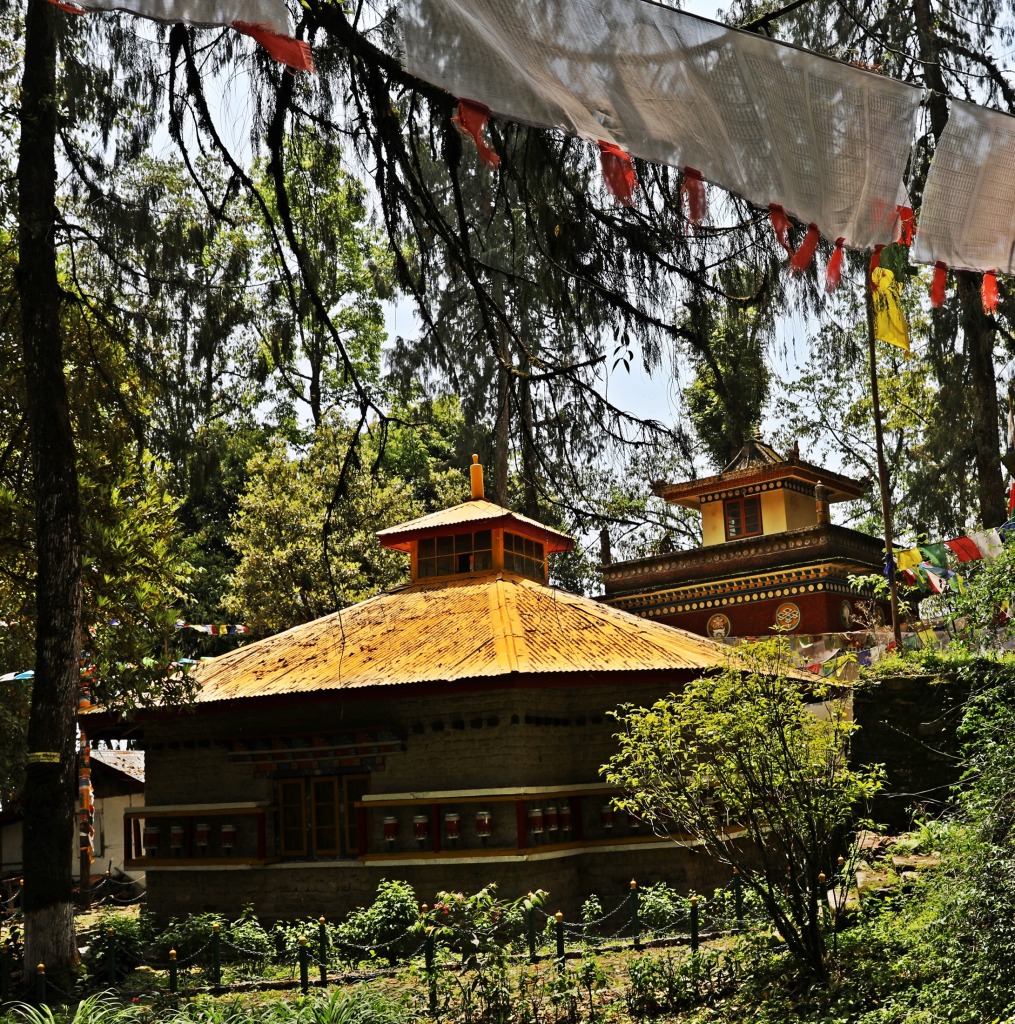
Temples, Norbugang Park 
Guru Rinpoche, Yuksom 
Norbugang Park, Yuksom 
Kartok Lake, Yuksom 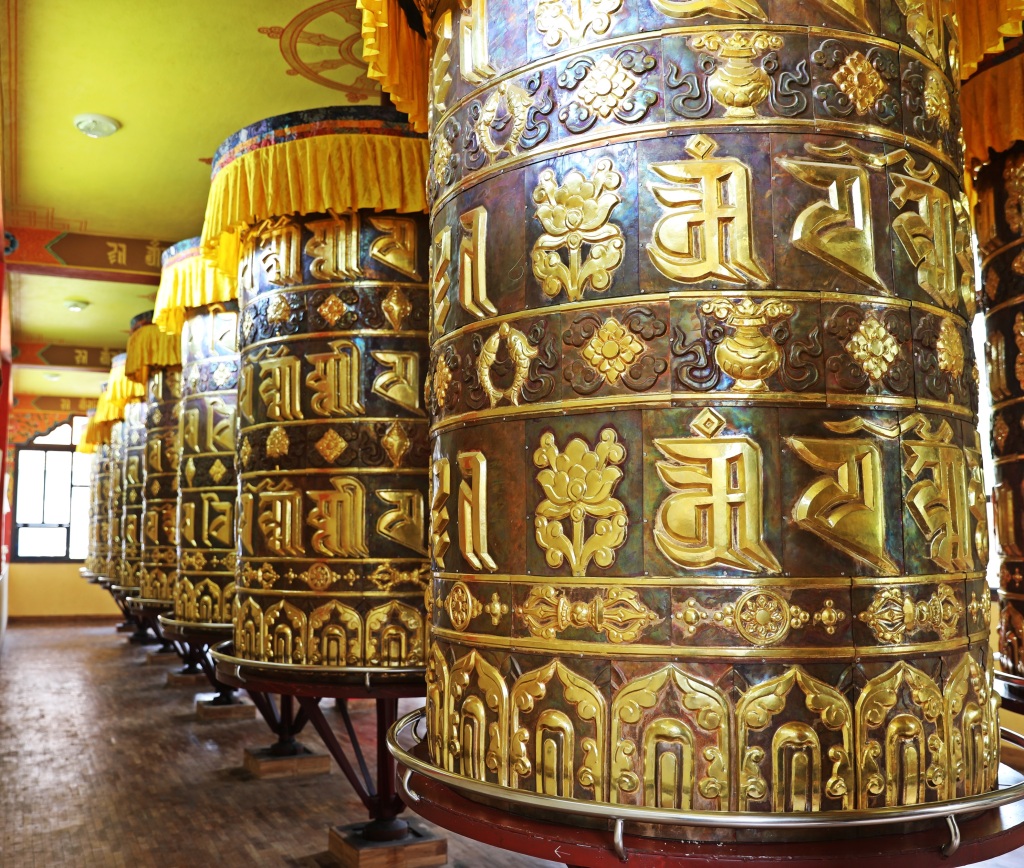
Prayer Wheels, Yuksom
Coming up next: Goecha La and Kanchenjunga
For extra pics from this trip go to Gallery/Northern India. For extra pictures from other blogs go to Gallery at monkeystale.ca
To read about more of our adventures go to Destinations.
If you like what you read, please comment or share it using the links below
Ah, such lovely pictures. You were so lucky or may be very patient to have these crowd free pictures.
LikeLiked by 2 people
Thanks, it was a little of both. It was the end of April/early May so there weren’t many tourists, but we also waited a lot for a clear shot.
LikeLiked by 1 person
Sikkim is one of our favourite states in the northeast. Can’t wait to read more! ❤
LikeLiked by 2 people
Thanks, just one trek left. We didn’t have much time in Sikkim but really enjoyed our trek.
LikeLiked by 1 person
Wow! What an amazing place. Great pictures, again. But it does kind of remind me of where I came from; I was born in the mountains too that’s why this piece made me feel a tad nostalgic. I’ve got to say, I love your Indian adventures. 🙂
LikeLiked by 2 people
Thanks Carl, we love the mountains too, that’s why so many of our posts are from mountain regions. You’ll like our next one too where we hike in Sikkim.
LikeLiked by 1 person
Beautiful pictures…keep sharing more
LikeLiked by 2 people
Thank you!
LikeLiked by 1 person
I always wanted to take that train! Thanks for the pictures
LikeLiked by 2 people
It’s the world’s slowest train and is probably much nicer in the sun, but it was fun.
LikeLiked by 1 person
Wow, what wonderful pictures! I found the train and the novice monks the most unique and interesting. Thanks for sharing!
LikeLiked by 2 people
Thank you so much for your kind words and for reading.
LikeLiked by 1 person
I too have (had) romantic notions of Darjeeling so it was interesting to read your impressions. Glad you enjoyed Sikkim and I look forward to reading about your trek. Wonderful photos, especially the novice monks (and monkeys always cute!).
LikeLiked by 2 people
Thanks Caroline. I felt like a Debbie-downer writing about Darjeeling, but I had to be honest. I think the weather played a part, but the buildings were the biggest disappointment. Again, high expectations are not always fulfilled.
LikeLiked by 1 person
Ya, I feel the same way about writing about a place that didn’t meet my expectations. Sometimes I shy away from writing about it altogether, which isn’t a good thing.
LikeLiked by 1 person
I just love your blog!!❤️️🤗
LikeLiked by 1 person
Thank you so much! It’s been fun making it!
LikeLike
🤗❤
LikeLike